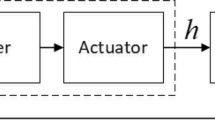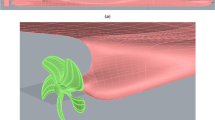Abstract
To reduce greenhouse gas emissions from ships as required by international environmental regulations, we propose herein an energy-saving method for ships sailing on wavy seas. The effect of applying this method is investigated by a numerical study of a bulk carrier self-propelled in regular head and following waves. The method requires that the ship be equipped with a controllable-pitch propeller (CPP) and an electric propulsion motor, which are controlled in an optimal manner to anticipate impending waves, thereby minimizing energy consumption. Optimal control is implemented using a nonlinear model predictive control method that uses information within a receding horizon to calculate the adjustments, which in turn control actuators that vary the propeller-pitch angle and the drive frequency of the motor. To implement this real-time application, we use a fast algorithm for solving the model predictive control problem. As a result, for a wave steepness of 0.01 and a unity ratio of wavelength to ship length, the energy required to propel a bulk carrier without optimal control is reduced by about 10% with the optimal-control system proposed herein.









Similar content being viewed by others
References
Shao W, Zhuo P (2011) Development of a dynamic programming method for low fuel consumption and low carbon emission from shipping, proceedings of the international conference on technologies, operations, logistics and modelling for low carbon shipping (LCS), Glasgow
The International Convention for the Prevention of Pollution from Ships, MARPOL, International Maritime Organization (IMO), (2011)
Armstrong VN (2013) Vessel optimization for low carbon shipping. Ocean Eng 73:195–207
Kumagai I, Takahashi Y, Murai Y (2015) Power-saving device for air bubble generation using a hydrofoil to reduce ship drag: theory, experiments, and application to ships. Ocean Eng 95:183–194
Webb GA (1983) A steady state control program to minimize fuel consumption for a vessel using a controllable pitch propeller, M. Sc. in Marine Engineering Thesis, University of Newcastle Upon Tyne
Matsunaga Y, Umeda N (2012) Energy efficiency improvement by optimal control of propeller pitch and electric propulsion for a ship in waves, Proceedings of the 11th International Marine Design Conference. University of Strathclyde, Glasgow, pp 533–543
Barclay A, Gill PE, Rosen JB (1998) SQP methods and their application to numerical optimal control. Int Ser Numer Math 124:207–222
Kitagawa Y, Tanizawa K, Hirata K, Ueno M, Umeda N, Fukazawa M, Komiya S (2013) Validation of optimal pitch control algorithm for energy efficient propulsion in waves, Conference Proceedings of the Japan Society of Naval Architects and Ocean Engineers, Vol. 16, pp 355–356
Kushida R, Umeda N, Sekiguchi H, Matsunaga Y (2012) Energy efficiency improvement by the use of a series hybrid propulsion system applied to a bulk carrier in head waves, Proceedings of the 6th Asia-Pacific Workshop on Marine Hydrodynamics, UTM (Johor), pp 483–488
Ohtsuka T (2004) A continuous/GMRES method for fast computation of nonlinear receding horizon control. Automatica 40:563–574
Umeda N, Hashimoto H (2002) Qualitative aspects of nonlinear ship motions in following and quartering seas with high forward velocity. J Mar Sci Technol 6:111–121
Hirayama T, Nomiyama DH, Nishimura K, Hirakawa Y, Takayama T (2005) Very short-term prediction of encountering waves utilizing marine radar, Proceedings of the 18th Ocean Engineering Symposium, The Society of Naval Architects of Japan, Vol. 18, CD-ROM
Acknowledgements
The research was supported by the Japan’s Ministry of Transport Land, Infrastructure, Transport and Tourism, Nippon Kaiji Kyokai (ClassNK) and Kamome Propeller Co., Ltd. as a research and development project for the next generation marine technology. This project launched with the initiative of Mr. Michikazu Sebe from the Ministry. Dr. Atsuo Maki, Mr. Yuta Sugihara, Mr. Yasunori Matsunaga, and Mr. Ryoma Kushida contributed to the numerical work described here. The authors express their sincere appreciation to these organizations and individuals.
Author information
Authors and Affiliations
Corresponding author
About this article
Cite this article
Makino, H., Umeda, N., Ohtsuka, T. et al. Energy savings for ship propulsion in waves based on real-time optimal control of propeller pitch and electric propulsion. J Mar Sci Technol 22, 546–558 (2017). https://doi.org/10.1007/s00773-017-0434-1
Received:
Accepted:
Published:
Issue Date:
DOI: https://doi.org/10.1007/s00773-017-0434-1




